On View
In Hawaii, Georgia O’Keeffe Found a Curious New Way to Look at Nature. An Immersive Show Lets You Mirror Her Journey
A Hawaiian paradise comes to the Bronx.
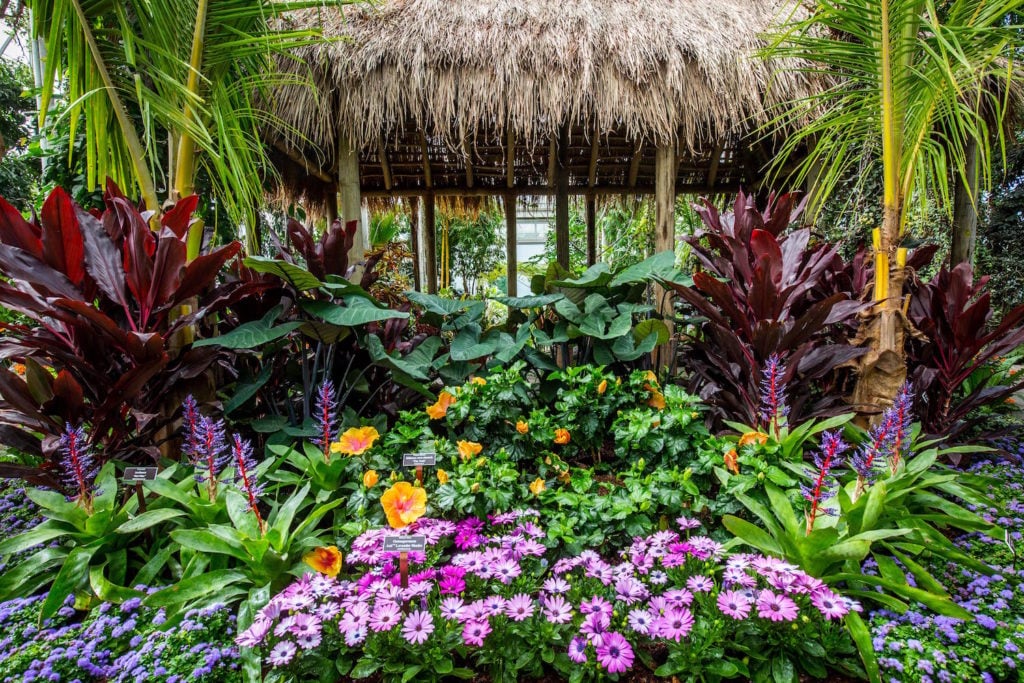
A Hawaiian paradise comes to the Bronx.

Sarah Cascone

Georgia O’Keeffe wasn’t particularly interested in visiting Hawaii, but when she was offered an all-expenses paid trip there in 1939, she couldn’t turn it down. Though the artist only spent nine weeks visiting the island paradise, tasked with making two ads for Dole pineapples, she completed no fewer than 20 paintings, an oft-forgotten body of work that takes center stage at the New York Botanical Garden this summer.
It’s the first time the group will be shown together in New York since their 1940 debut at An American Place, the gallery run by O’Keeffe’s husband, photographer Alfred Stieglitz. “They’ve come full circle, since the first time they were exhibited was here in New York,” said exhibition curator Theresa Papanikolas at a press preview.
In addition to reuniting 17 of O’Keeffe’s Hawaii paintings—an 18th, Hibiscus, sold for $4.8 million at Tuesday’s American art sale at Christie’s and may be included in subsequent stops on the show’s tour—the exhibition showcases the flowers and plants of Hawaii that so inspired the artist.
The garden’s central conservatory has been transformed into a tropical paradise, full of rare Hawaiian plants, many of which gifts from Hawaii’s National Tropical Botanical Garden. Also included is a traditional thatched hale structure by Broadway set designer Scott Pask.
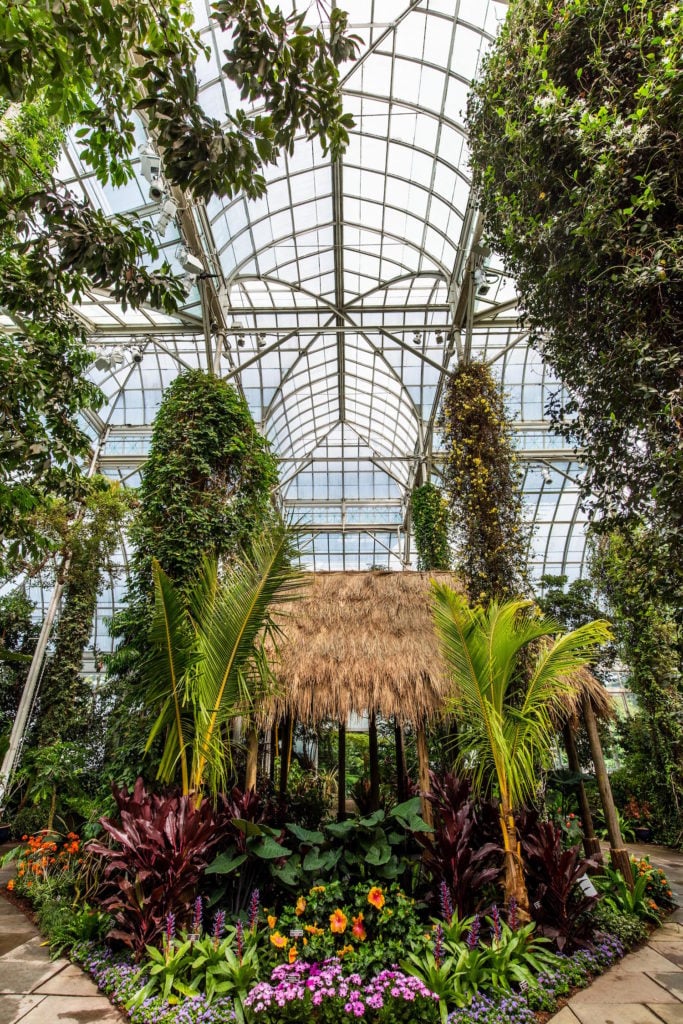
“Georgia O’Keeffe: Visions of Hawai’i” at the New York Botanical Garden. Photo courtesy of the New York Botanical Garden.
“Georgia O’Keeffe: Visions of Hawai’i” is part of an exhibition series at the NYBG that “takes a well-known figure who has a connection to the plant world that is not so well-known,” explained Todd Forrest, the garden’s vice president for horticulture and living collections. Past examples include Charles Darwin and Frida Kahlo, as well as more obvious choices like Claude Monet.
O’Keeffe, of course, is probably the most famous painter of flowers in art history—a designation she had already earned by the time she visited Hawaii. (The show includes an archival newspaper article with a photo of O’Keeffe in a lei that heralds her as such.)
Nevertheless, few are aware of her connection to the Hawaiian islands. Papanikolas, for instance, only learned of the paintings when she was applying to work at the Honolulu Museum of Art, where she is now curator of European and American art.
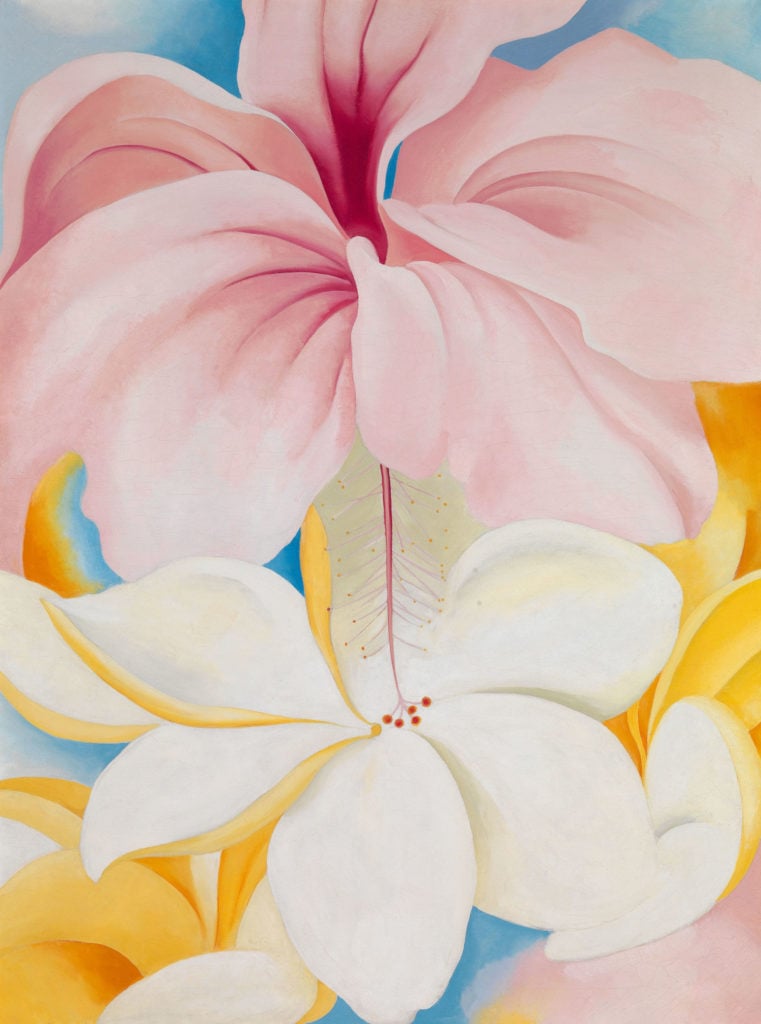
Georgia O’Keeffe, Hibiscus with Plumeria (1939). Courtesy of the Smithsonian American Art Museum, © 2018 Georgia O’Keeffe Museum/Artists Rights Society (ARS), New York.
During the interview process, she was surprised to see the museum’s collection included some of these unfamiliar O’Keeffe works, and even more surprised when her future boss dismissed them as unimportant. “I’ve spent the last 10 years proving him wrong!” Papanikolas exclaimed. (A show of the works she organized in 2013 set the wheels in motion for the current NYBG exhibition.)
Upon her arrival in Hawaii, O’Keeffe was introduced to the upper crust of local society, staying at the finest hotels and visiting the homes and gardens of the wealthy. Everywhere she went, she was showered with flowers, which are “very much part of the daily existence in Hawaii,” according to Papanikolas.
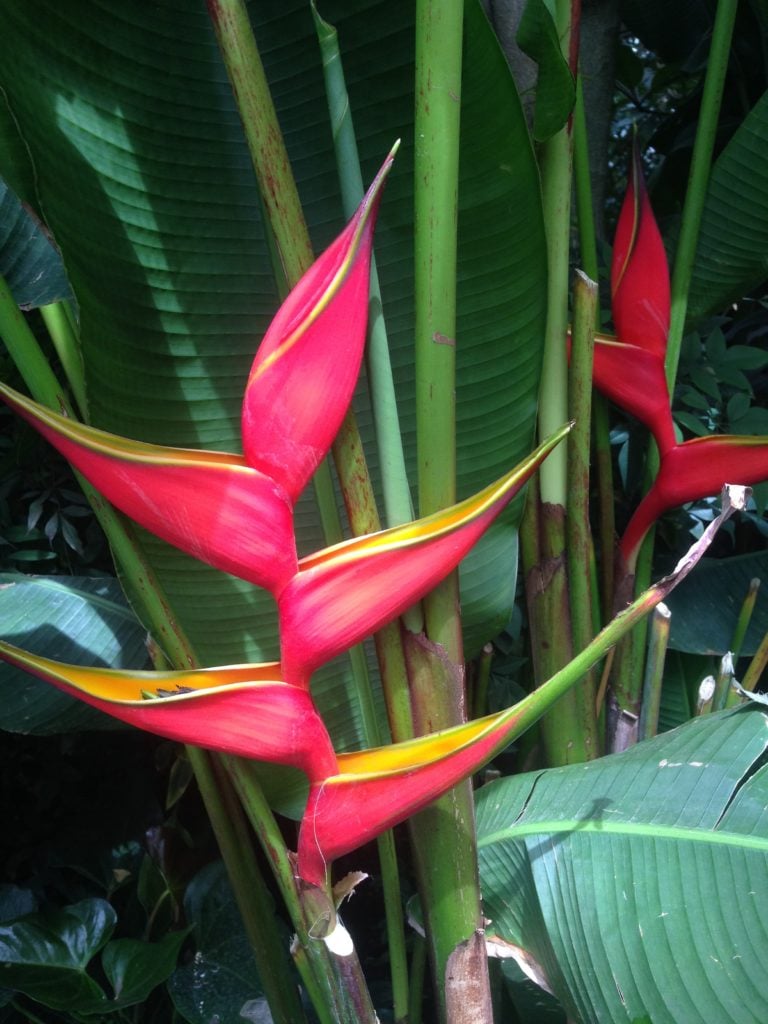
A heliconia in “Georgia O’Keeffe: Visions of Hawai’i” at the New York Botanical Garden. Photo courtesy of Sarah Cascone.
Perhaps unsurprisingly, she was first drawn to the belladonna, which bore a striking resemblance to the Jimson weed, the subject of one of her best-known—not to mention most expensive—canvases.
On the island of Maui, O’Keeffe drew inspiration from the coast’s volcanic landscape, frozen lava flows juxtaposed with the crashing ocean waves. She had learned to drive in her beloved New Mexico, a skill that served her well in Hawaii, where, with her 12-year-old guide, she clambered over rocks to explore remote regions, painting as she went. The same sense of alien beauty that she so famously captured in her New Mexico landscapes permeates these canvases.
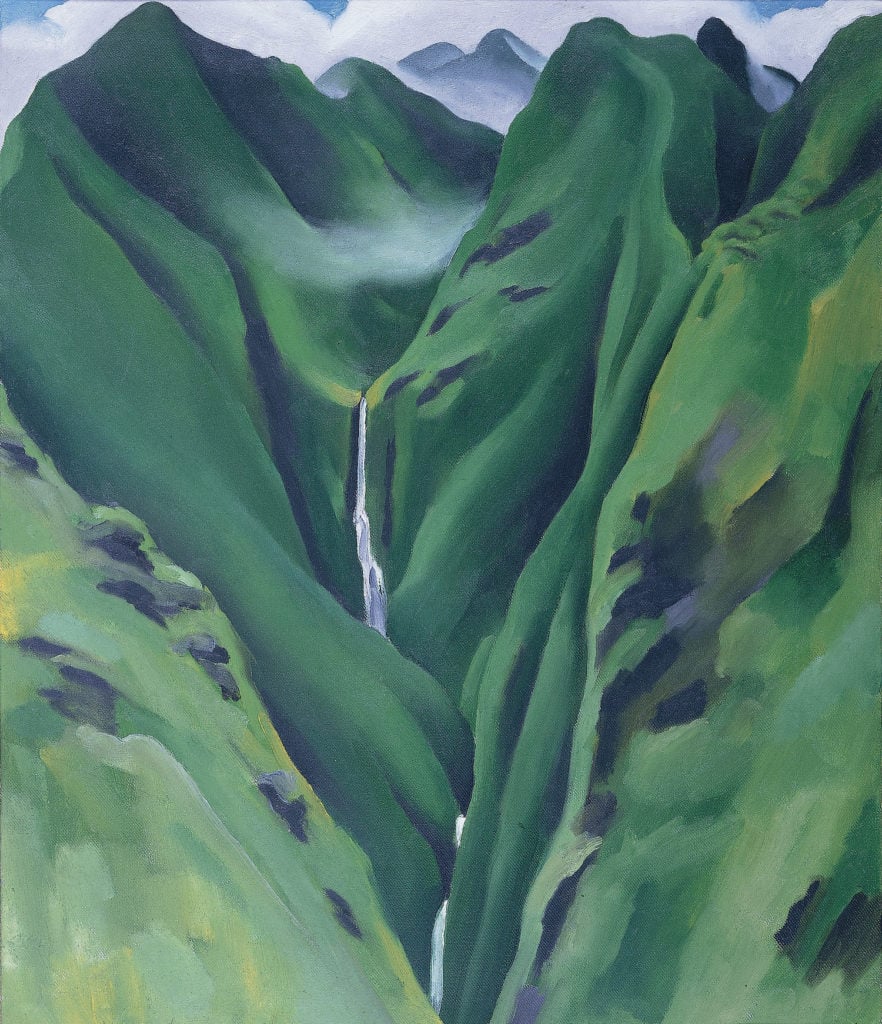
Georgia O’Keeffe, Waterfall, No. I, ‘Īao Valley, Maui (1939). Courtesy of the Memphis Brooks Museum of Art, Memphis, Tennessee © 2018 Georgia O’Keeffe Museum/Artists Rights Society (ARS), New York.
Ironically, the one thing that O’Keeffe neglected to paint was a pineapple. After the trip, she turned two pieces into Dole, then known as the Hawaiian Pineapple Company: Heliconia, Crab’s Claw Ginger and Papaya Tree, ‘Íao Valley, Maui.
“The papaya tree, needless to say, was rejected because the papaya was the rival fruit to the pineapple,” said Papanikolas. Upon her return to New York, Dole sent her a pineapple so she could finish the assignment. All three canvases are on view at the NYBG, plus copies of the final ads as they appeared in the Saturday Evening Post and Women’s Home Companion.
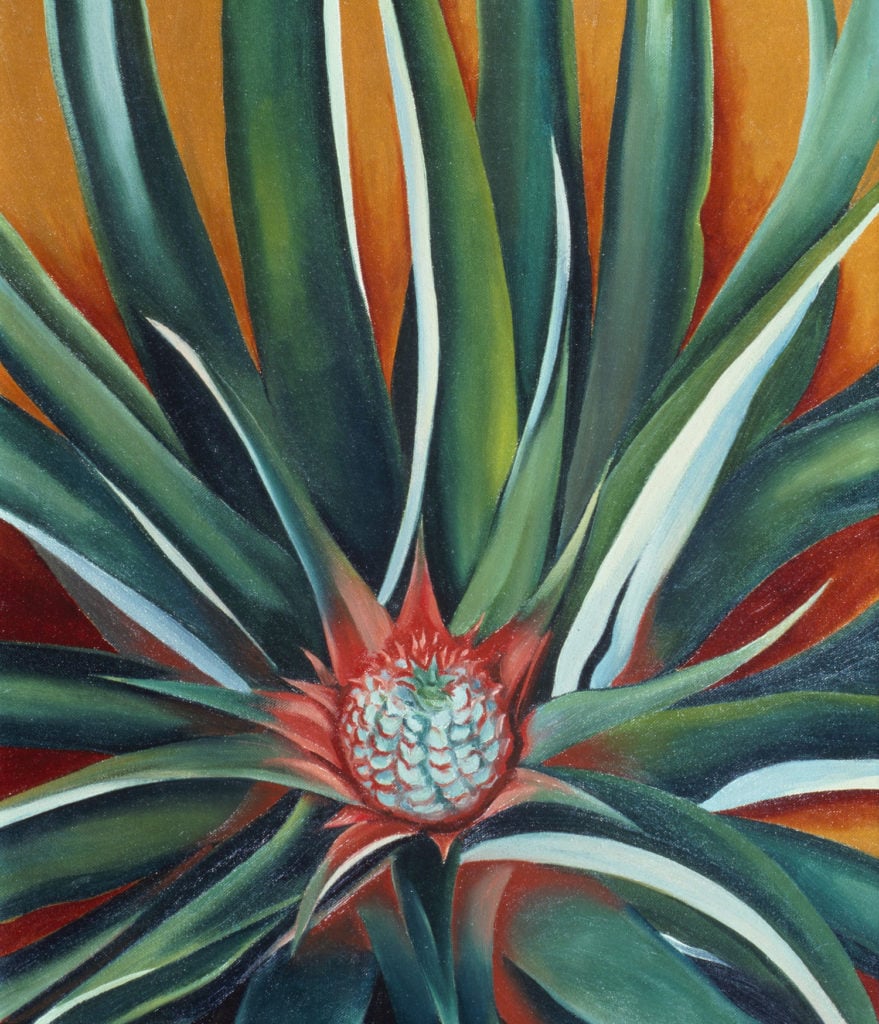
Georgia O’Keeffe, Pineapple Bud (1939). Courtesy of a private collection, © 2018 Georgia O’Keeffe Museum/Artists Rights Society (ARS), New York.
What O’Keeffe might have been surprised to learn, however, was that none of the flowers she painted were actually native to Hawaii. Pineapple, hibiscus, bougainvillea, plumeria, and many of the other plants that we typically associate with the Hawaiian islands were actually brought there by mankind.
“If you were to have gardens of only native Hawaiian plants, it would look nothing like the Hawaii O’Keeffe painted,” said NYBG interpretive specialist Victoria Lewis. The islands’ current vegetation includes two waves of imported plant life: the so-called canoe plants, brought from Polynesia some 1,500 years ago by Hawaii’s first settlers, and those introduced by Westerners following the arrival of Captain Cook in the late 18th century.
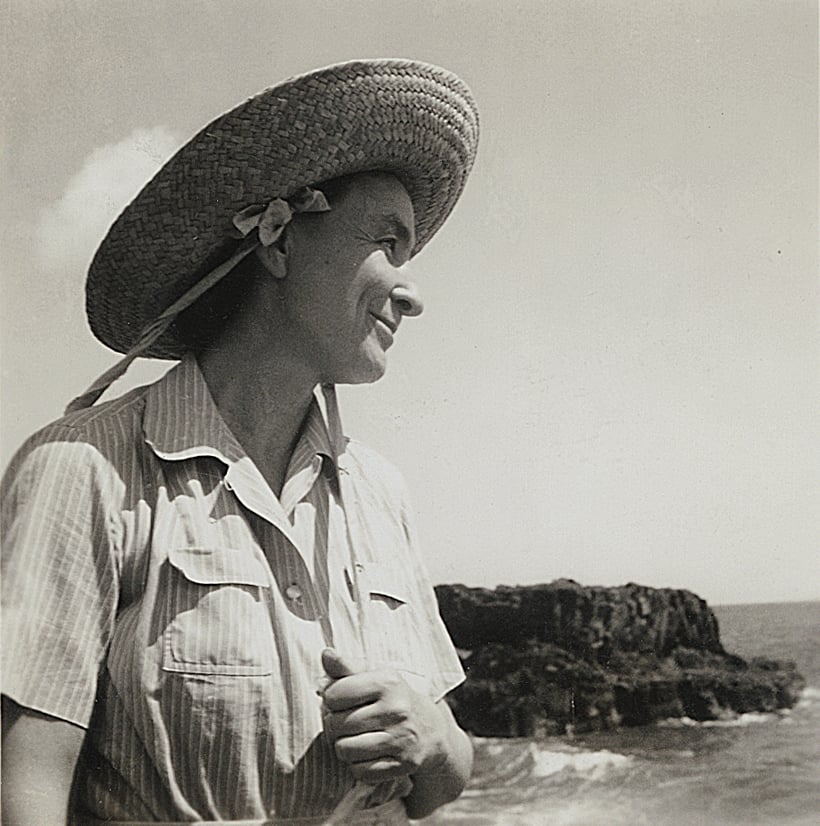
Harold Stein, Georgia O’Keeffe on Leho‘ula Beach, near Aleamai, Hāna, Maui (1939). Photo courtesy of the Alfred Stieglitz/Georgia O’Keeffe Archive, Yale Collection of American Literature Beinecke Rare Book and Manuscript Library.
The canoe plants include sugarcane, tea, and breadfruit—plants that were “multi-purpose and multifunctional, which was why they brought them,” said Lewis. The modern introductions include many of the ornamental garden plants associated with Hawaii today, as well as the iconic pineapple. The exhibition also touches on invasive plants such miconia, and they threat they pose to the islands’ biodiversity.
Of the islands’ 1,200 native species of plant life, 90 percent are endemic, meaning that they grow nowhere else in the world. Half are endangered. This posed a challenge for the show’s organizers. “You cannot ship endangered native species across state lines,” noted Lewis. Gorgeous paper sculptures, created by the NYBG botanist and artist Charles Zimmerman, stand in for some of the more exotic varieties that were impossible to source.
Georgia O’Keeffe, Heliconia, Crab’s Claw Ginger (1939). Courtesy of Sharon Twigg-Smith, © 2018 Georgia O’Keeffe Museum/Artists Rights Society (ARS), New York.
The show also details O’Keeffe’s journey, with a map tracing her arrival on the SS Lurline and subsequent island-hopping, a copy of the guidebook she carried, and a set of “Flowers of Hawaii” postcards that she purchased during her stay. There are also excerpts from the missives O’Keeffe sent to Stieglitz back in New York—as much love letters to Hawaii as to her husband—and travel snapshots taken by the artist herself.
“You don’t necessarily think of O’Keeffe as a photographer, but she made at least 20 photographs of Hawaii,” said Papanikolas.
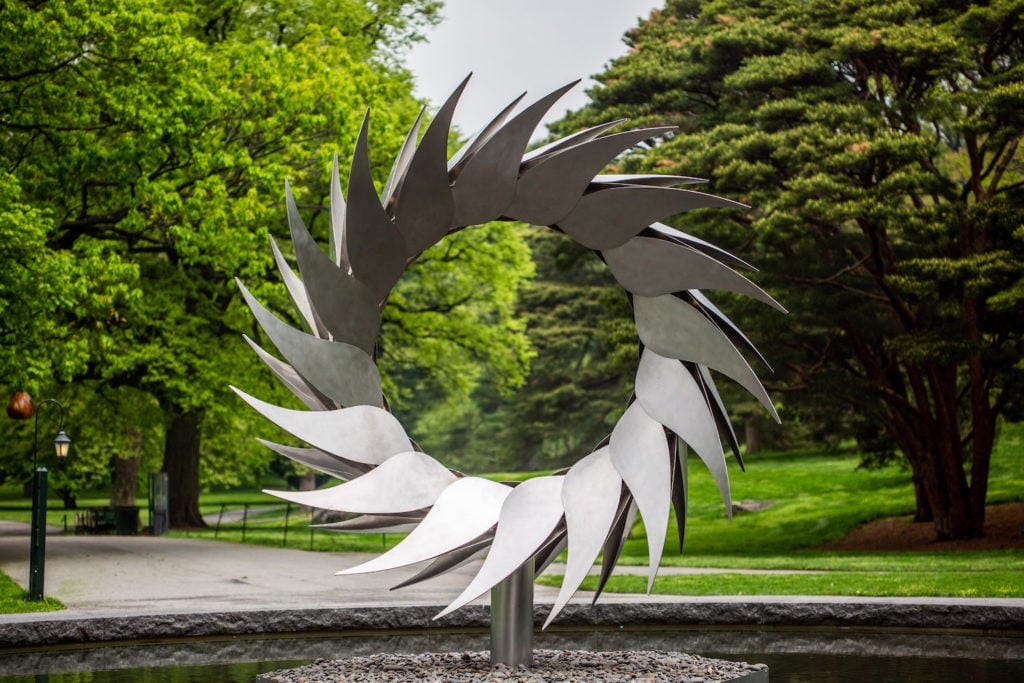
Marc Chai, Heliconia Loop in “Georgia O’Keeffe: Visions of Hawai’i” at the New York Botanical Garden. Photo courtesy of the New York Botanical Garden.
The garden looks beyond O’Keeffe as well. Greeting visitors at the entrance’s reflecting pool is a massive stainless steel sculpture by Hawaiian artist Mark Chai. The sun-shaped work is actually inspired by one of O’Keeffe’s paintings.
Completing the celebration of Hawaii is a full slate of programming, with music performances, a fashion show, and a traditional tattoo demonstration, plus a food truck serving poke. As Gregory Long, the NYBG’s president and CEO, put it, “It’s a garden-wide party that lasts the whole summer.”
“Georgia O’Keeffe: Visions of Hawai’i” is on view at the New York Botanical Garden, 2900 Southern Boulevard, Bronx, May 19–October 28, 2018.